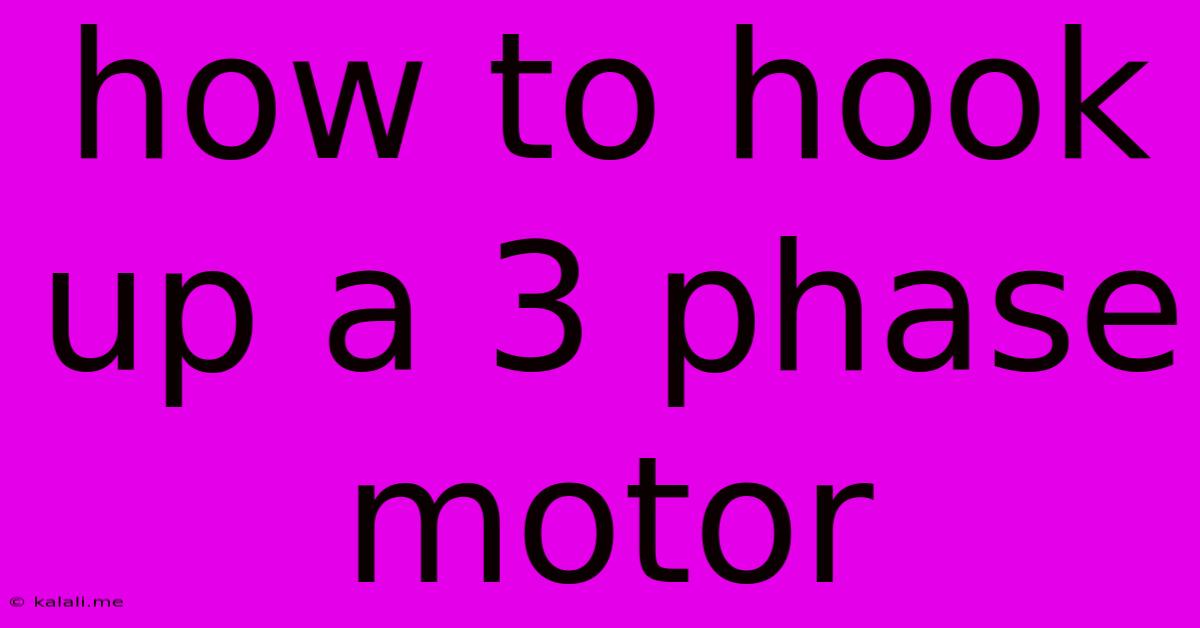How To Hook Up A 3 Phase Motor
Kalali
May 31, 2025 · 3 min read

Table of Contents
How to Hook Up a 3-Phase Motor: A Comprehensive Guide
Connecting a three-phase motor might seem daunting, but with a clear understanding of the process and safety precautions, it's a manageable task. This guide will walk you through the steps, ensuring you can safely and correctly connect your three-phase motor to your power supply. This involves understanding motor specifications, wiring diagrams, and crucial safety measures. Improper connection can lead to motor damage or even electrical hazards.
Understanding Your 3-Phase Motor
Before you begin, you need to gather some crucial information about your motor. This includes:
- Voltage: Determine the motor's rated voltage (e.g., 230V, 460V). Connecting it to an incorrect voltage will severely damage the motor.
- Amperage: Find the motor's full-load amperage (FLA). This helps you select the correct size of circuit breaker and wiring.
- Wiring Diagram: Locate the motor's wiring diagram, usually found on the motor's nameplate or in the accompanying documentation. This diagram is crucial for correct connection. It will show you the terminal connections for different configurations (Delta and Wye).
- Rotation: Note the direction of rotation specified on the nameplate. You might need to reverse the phase sequence to change the motor's rotation.
Essential Safety Precautions
Safety is paramount. Always disconnect the power supply before working on any electrical equipment. This is non-negotiable. Further safety measures include:
- Lockout/Tagout: Use a lockout/tagout procedure to prevent accidental power restoration.
- Personal Protective Equipment (PPE): Wear appropriate PPE, including safety glasses and insulated gloves.
- Proper Tools: Use insulated tools rated for the voltage level of your power supply.
- Consult an Electrician: If you are unsure about any aspect of the process, consult a qualified electrician. Improper wiring can lead to serious injury or equipment damage.
Connecting the Motor: Delta and Wye Configurations
Three-phase motors can be wired in two main configurations: Delta (Δ) and Wye (Y). The choice depends on the motor's specifications and the available power supply.
Delta (Δ) Connection
The Delta connection is characterized by connecting the three phases directly to each other, forming a triangle. This configuration is commonly used with higher voltage systems. The wiring diagram will clearly illustrate the terminal connections for a Delta configuration. Follow the diagram precisely.
- Wiring: Connect the three power supply lines (L1, L2, L3) directly to the three motor terminals (usually numbered T1, T2, T3). The exact connection sequence will depend on the motor's wiring diagram.
Wye (Y) Connection
The Wye connection connects the three phases to a common neutral point, forming a "Y" shape. It is often used with lower voltage systems.
- Wiring: Connect each power supply line (L1, L2, L3) to one of the three motor terminals (usually T1, T2, T3). The common neutral point may or may not be used depending on the system's requirements. Again, consult your motor's wiring diagram.
Testing the Motor
After connecting the motor, carefully restore power. Observe the motor's operation closely.
- Rotation: Check the direction of rotation. If it's incorrect, you'll need to swap two of the power supply lines to reverse the phase sequence.
- Overheating: Monitor the motor for any signs of overheating. This could indicate a problem with the wiring or the motor itself.
- Unusual Noises: Listen for any unusual noises that might suggest a problem.
Troubleshooting Common Issues
If your motor isn't running correctly, here are some common problems to investigate:
- Incorrect Wiring: Double-check all connections to ensure they match the motor's wiring diagram.
- Blown Fuse/Tripped Breaker: A blown fuse or tripped breaker indicates a potential short circuit or overload.
- Motor Failure: If you've ruled out wiring issues, there may be a fault within the motor itself.
Connecting a three-phase motor requires careful attention to detail and a strong emphasis on safety. By following this guide and prioritizing safety, you can successfully connect and operate your three-phase motor. Remember to always consult professional help when in doubt.
Latest Posts
Latest Posts
-
What Happened After The Fall Of Rome
Jun 02, 2025
-
How To Fix Loose Fence Post In Concrete
Jun 02, 2025
-
Can Your Phone Double As A Walkie Talkie
Jun 02, 2025
-
How Do I Find The Perimeter Of A Triangle
Jun 02, 2025
-
How To Calculate Rsu Cost Basis
Jun 02, 2025
Related Post
Thank you for visiting our website which covers about How To Hook Up A 3 Phase Motor . We hope the information provided has been useful to you. Feel free to contact us if you have any questions or need further assistance. See you next time and don't miss to bookmark.